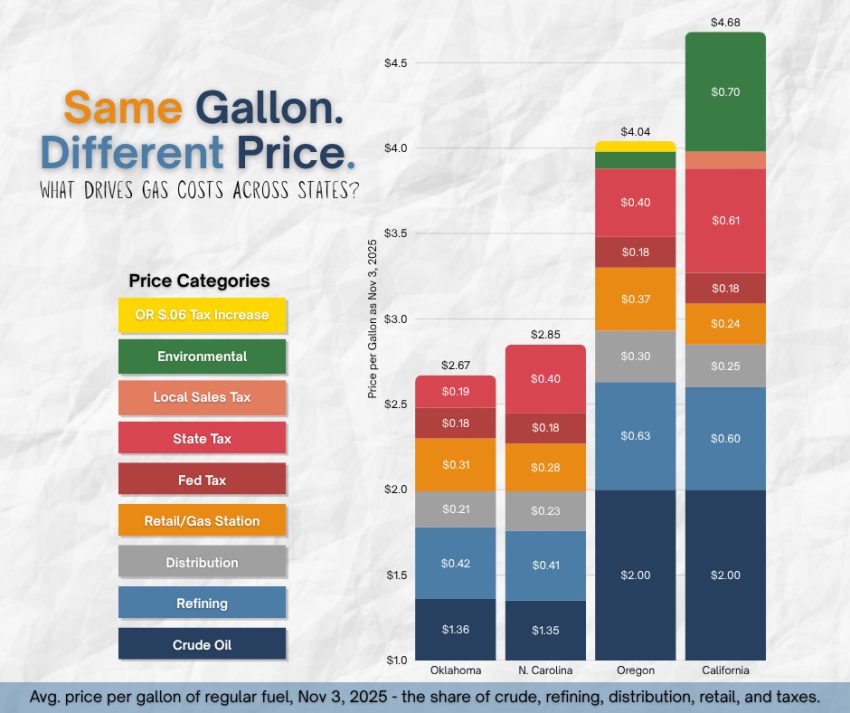EDITOR’S NOTE: Here’s an installment from Tillamook County’s State Representative Cyrus Javadi’s Substack blog, “A Point of Personal Privilege.” Oregon legislator and local dentist. Representing District 32, a focus on practical policies and community well-being. This space offers insights on state issues, reflections on leadership, and stories from the Oregon coast, fostering thoughtful dialogue. Posted on Substack, 11/4/25
Why Oregon pays more at the pump, and why it has more to do with geography than to do with politics.
By State Representative Cyrus Javadi
Every few months, someone sidles up to me and asks, “Cyrus, why does Oregon gas cost so much more than everywhere else?”
Usually, they’re polite about it. Sometimes, not so much. But the question is always the same: If oil prices are the same everywhere, and we pay about the same taxes as other states, why are we stuck with $4 gas while Idaho or North Carolina are around $3?
It’s a fair question. And it deserves a straight answer, one rooted in how the market actually works, not how politics explains it.
The Myth of the Political Pump
Let’s start with the myth that powers every comment section from Medford to Myrtle Point: that gas prices are high because of “Democrat policies.”
It’s a tidy story. It’s also wrong.
Oregon’s gas tax, the one everyone loves to blame, sits at 40 cents a gallon. Which, by the way, is exactly what North Carolina charges.
And then there’s New Mexico. Deep-blue, Democrat governor, Democrat legislature. Yet their gas averages $2.75 a gallon, right in line with Texas and Oklahoma.
If politics really ran the pump, that wouldn’t make any sense.
What New Mexico shows is that pipelines beat party lines. Geography and infrastructure matter a lot more than whoever’s in the governor’s chair. The state sits in the middle of America’s crude network, close to refineries, and that keeps prices low.
Meanwhile, back in Oregon, our tax bumps up another six cents in January from 40 to 46. Not nothing, sure. But it doesn’t explain why gas in North Carolina is $2.75 while ours is hovering around $3.88.
If taxes or party labels were the main driver, those numbers would move together.
They don’t.
Because what’s really driving the difference isn’t politics.
The Real Drivers of Price
Imagine a gallon of gas as a kind of layer cake. The top layer, the part that stings when you swipe your card, is built on several smaller, hidden layers underneath.
- Crude oil: roughly 50–55% of the price.
- Refining: 15–20%.
- Distribution, marketing, and retail: 15–20%.
- Taxes and environmental programs: 10–15%.
Now, these layers don’t stay the same everywhere. Crude oil prices might be set globally, but the cost of getting that crude to a refinery, turning it into gasoline, and getting it to your local station varies dramatically depending on where you live.
Oklahoma, the cheapest fuel in the nation yesterday, sits right on top of the nation’s crude pipeline network.
Oregon, by contrast, sits at the end of it.
Why does that matter? Because, Oregon is supplied mostly by Washington State refineries that use a mix of Alaskan North Slope and imported crude. Those barrels cost more to ship, and the refineries processing them are smaller, older, and under tighter environmental regulations.
So before Oregon’s fuel even leaves the refinery, it’s already more expensive.
Refineries: The Hidden Bottleneck
If you really want to know why the West Coast pays more, look at what’s happened to refinery capacity over the last decade.
The number of refineries operating in the western U.S. has declined steadily, and several of those that remain have reduced output or converted part of their operations to produce renewable diesel instead of traditional gasoline. That shift was driven partly by state and federal clean-fuel policies, partly by market demand, and partly by the sheer cost of maintaining older, complex facilities.
The result is the same: less capacity, fewer suppliers, and higher margins for the refineries that remain. When one or two go offline for maintenance, as happened this fall, prices in Oregon and Washington jump almost overnight. There’s no backup pipeline from the Gulf Coast and no easy way to reroute supply.
It’s like living at the end of a single-lane road: when traffic slows, there’s nowhere to detour.
Crude Confusion
One of my colleagues recently said: “Crude oil prices are the same nationwide. It’s Oregon’s policies that make gas expensive.”
That sounds good in a debate. It’s also not true.
Yes, global crude prices are roughly the same. But refineries don’t pay “the global price.” They pay what it costs to get a specific type of crude delivered to their facility. Gulf Coast refineries use cheap, light, sweet crude piped directly from Texas and Oklahoma. West Coast refineries buy heavier, imported barrels that must travel by tanker.
Add marine shipping, insurance, and port fees, and suddenly the “same crude” costs $5–$7 more per barrel to a refinery in Anacortes than to one in Houston.
That difference flows straight into your pump price.
The Environmental Surcharge (and What It Really Does)
Now, Oregon does have an environmental cost built into fuel. It’s roughly 10 cents per gallon under the Clean Fuels Program. The goal is to encourage lower-carbon fuel production over time. Reasonable people can debate whether that’s the right approach, but even if you scrapped it entirely, you’d still be paying around $4.17, not $3.00.
That 10 cents doesn’t explain the gap.
What’s really driving the difference is that the West Coast fuel market is smaller, more isolated, and more expensive to operate in than anywhere else in the continental U.S.
The Pandemic Shock That Never Fully Unwound
In 2020, when COVID froze the global economy, oil prices actually went negative. Yes, literally below zero. You could have been paid to take a barrel of crude off someone’s hands. That’s why gas dropped below $2 in some parts of the country.
Since then, demand has come roaring back. But supply hasn’t.
Refineries that shut down during the pandemic never restarted, and new ones are almost impossible to build. Meanwhile, inflation has hit every step of the supply chain: labor, maintenance, electricity, trucking, credit card fees — all up.
So when people point back to 2020 and say, “Gas was $2.22 when Trump left office,” what they’re really remembering is an anomaly. Basically, a once-in-a-century crash that temporarily broke the energy market.
Politics vs. Physics
It’s tempting to believe gas prices rise and fall with whoever’s in charge.
But crude oil doesn’t vote. Refineries don’t read party platforms.
When the world economy collapsed in 2020, prices fell no matter who was in the White House. When global demand recovered faster than supply in 2022, prices spiked everywhere, red states, blue states, and everything in between.
Oregon’s environmental policies, for better or worse, exist within that global market. They can add a few cents here or there, but they don’t explain a dollar or two difference.
The Six-Cent Controversy
Now, about that six-cent gas tax.
Republicans are gathering signatures to refer the bill to voters, arguing that Oregonians can’t afford higher fuel costs. I don’t disagree with the sentiment, gas is expensive, and any new cost adds pressure on families.
But the claim that the six cents caused high prices simply isn’t true.
Our gas is already expensive because of refinery bottlenecks and a constrained supply chain. That’s not something the Legislature can fix with a vote. The tax funds road maintenance, and given how our infrastructure is aging, ignoring that problem would cost even more in the long run.
People can disagree on whether six cents is worth it, but they should do so based on facts.
Why Idaho Isn’t a Fair Comparison
Drive across the Snake River, and you’ll see gas 60 cents cheaper. Same geography, same region, same federal tax. What gives?
The answer is that Idaho buys its fuel from a different market.
Western Idaho gets gas from Utah refineries through pipelines running north from Salt Lake City, which has cheaper crude, cheaper refining, and cheaper distribution.
Oregon, by contrast, relies almost entirely on refineries in Washington that face higher costs and stricter requirements.
So yes, it’s a big difference, but not because Salem raised your taxes. It’s because Oregon sits at the end of an expensive, undersized supply chain.
The Adult Conversation
Here’s where I land.
Gas prices are frustrating. Nobody likes paying $4. But we can’t fix a market problem with a bumper-sticker solution. Pretending that Salem controls global crude prices or refinery capacity might win a few likes online, but it doesn’t fix roads, stabilize supply, or tell voters the truth.
If the debate is whether to fund transportation responsibly or let our infrastructure crumble, that’s an honest disagreement. But if the debate is whether Oregon’s environmental programs or a six-cent tax are secretly driving global oil markets, that’s political theater.
We owe Oregonians better than that.
The Bigger Picture
So, the next time someone sidles up to you and asks, “Hey, why does Oregon gas cost so much more than everywhere else?”, you can tell them the truth.
It’s not because Salem raised a tax. It’s not because of who’s in the governor’s chair. And it’s not because crude oil suddenly started caring about party affiliation.
It’s because Oregon sits at the end of a long, narrow supply chain fed by older refineries, limited pipelines, and a regional market that can’t easily import more fuel when something goes wrong.
We’re paying a premium for geography, not ideology.
Crude may be a global commodity, but the cost of turning it into a gallon of gas depends on where you live, how far it has to travel, and how many bottlenecks it passes through on the way.
That’s why Idaho can fill up on $3 gas from Utah refineries while we hover closer to $4.
The market sets the price. Geography decides how much it hurts. Politics just argues about it.


